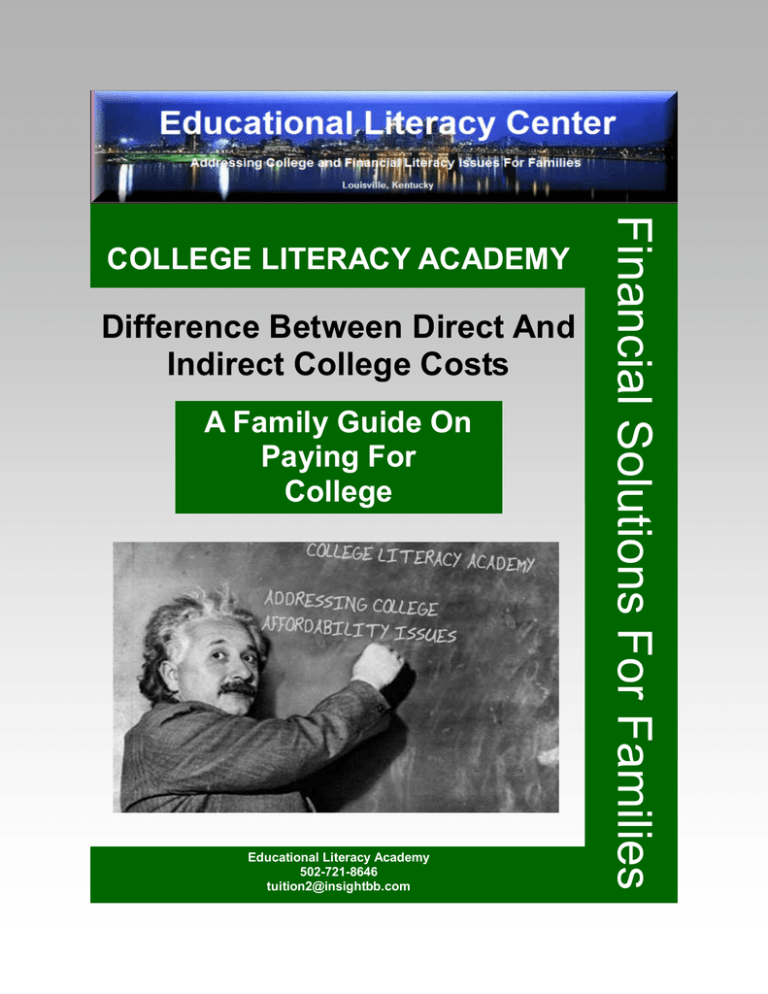
Difference Between Direct And
Indirect College Costs
A Family Guide On
Paying For
College
Educational Literacy Academy
502-721-8646
tuition2@insightbb.com
Financial Solutions For Families
COLLEGE LITERACY ACADEMY
Understanding How To
Pay For College
(Ninth Edition)
Copyright 2003, 2004, 2005, 2006, 2007, 2008, 2009, 2010, 2011
By: Educational Literacy Center
All Rights Reserved
No part of this publication may be used or reproduced in any manner
whatsoever without written permission except in the case of brief
quotations embodied in critical articles and reviews.
For More Information Contact:
Chuck Moore, CCFC, CAMC, CAFC
Louisville, Ky 40207
Ph. 502-721-8646
Cell 502-931-3137
tuition2@insightbb.com
www.collegeliteracyacademy.com
This publication is general in nature and is not intended to give legal, accounting or investment
advice. Before incorporating any ideas in this publication the reader should consult
with their financial advisor, guidance counselor, or tax professional. Some of
the information provide in this publication is from IRS Publication 970,
Federal Financial Aid System and other resource material
Direct And Indirect
College Costs
What Is The Difference Between Direct And Indirect College Costs
When families first are exposed to college bills, many are confused on who to write the
checks out to.
Paying for the cost of college comes in two forms:
��
Direct Costs
�� Indirect Costs
The first thing families need to understand is what is called the Total Cost Of Attending
or COA.
The COA is the accumulation of all costs that relate to getting a degree or certification
from an educational institution. These costs are as follows:
��
Tuition and Fees
��
Room and Board
��
Books and Supplies
�� Personal Miscellaneous Costs
Direct Costs are defined as any monies paid DIRECTLY to the college or university
such as:
��
Tuition: If the student has selected a state school, the tuition (cost of classes) will
depend on his or her residency status. The difference between in-state and out-ofstate tuition can be thousands of dollars a year. Some schools base tuition on the
number of credit hours taken in an academic period. Others rely on enrollment
status (full time versus part time).
��
Fees: Most schools charge set fees for services such as activities or athletic facilities. Such fees usually appear on the tuition bill whether the student uses these
services or not.
��
On-campus room and board: The student may choose to live on campus and eat
in dining facilities. Meal plans prices can vary significantly.
Indirect Costs are defined as any monies paid for other educational expenses that
have an indirect link other than Direct Costs, such as:
��
Books and supplies: Textbook costs are similar from school to school, but they
vary greatly depending on the courses taken. Students can save by buying used
books, buying online, or sharing with classmates. Some classes require more
supplies than others; others have printing, copying, or computer costs.
��
Computers: Many schools require students to have a personal computer. Check
the admissions requirements to determine whether a basic PC will do or a more
expensive laptop is required. Remember to add the costs of software, a printer,
and — if your child lives off campus — connection to the Internet.
��
Off-campus room and board: This category includes rent, furnishings, utilities,
and meals. Even if your child lives at home, there will be expenses related to food
and commuting.
��
Transportation: If the student will commute to school, factor in the cost of public
transportation, gas, car insurance, maintenance, and parking fees. Some schools
provide free parking, while others require a paid permit. If the school is far away,
don’t forget the cost of air travel to get home on breaks and holidays. The student
can lower these costs by carpooling and by shopping around for student rates on
airfare.
��
Personal expenses: Students have lots of small personal expenses that add up
and can make a huge difference in this category. Consider clothing, laundry,
haircuts, cell phone, and entertainment. Teach your child to maintain a written
budget since these expenses can easily spiral out of control.
��
Other costs: Count on extra expenses such as lab fees for science courses, fees
for course changes, and expenses for participating in athletics or joining a sorority
or fraternity. Try to keep a little extra money in the budget to cover emergencies.


